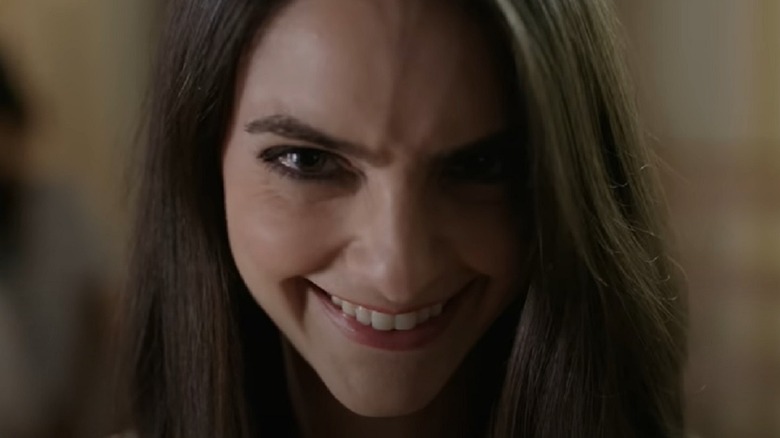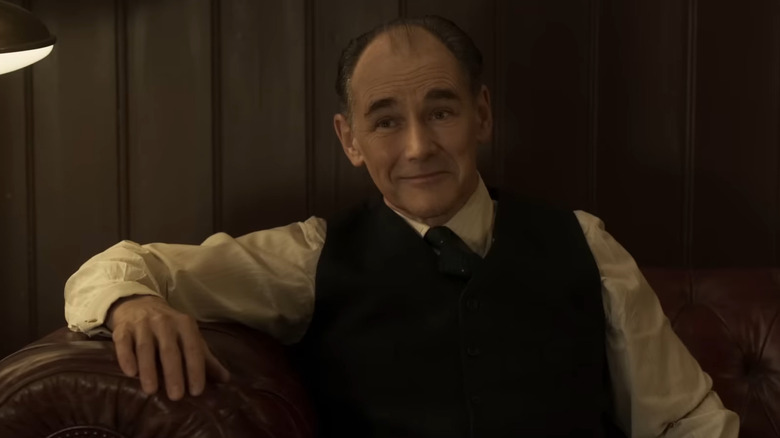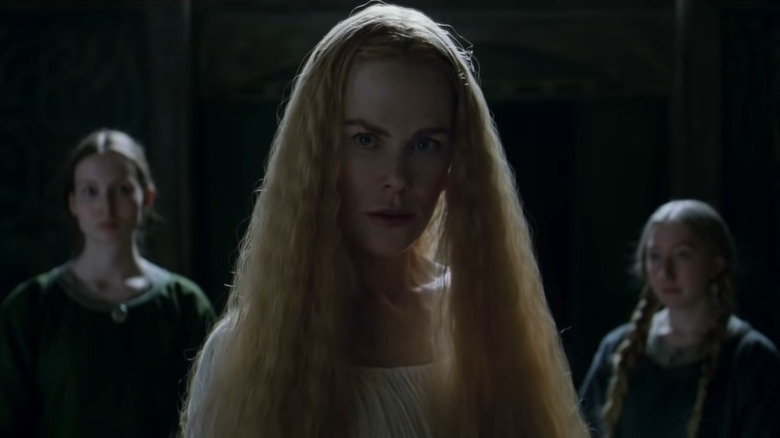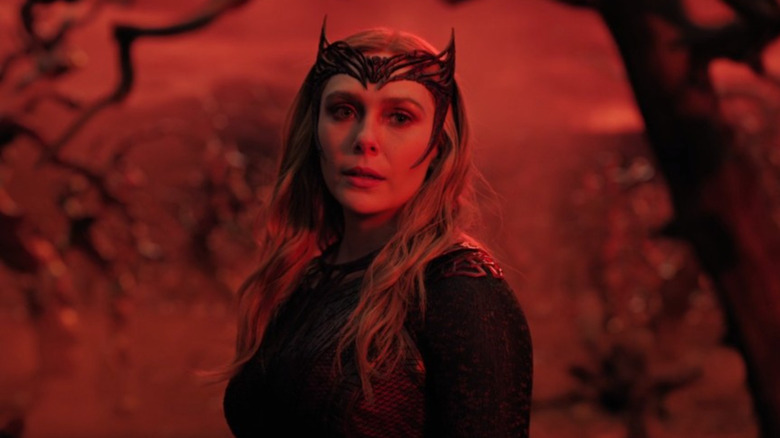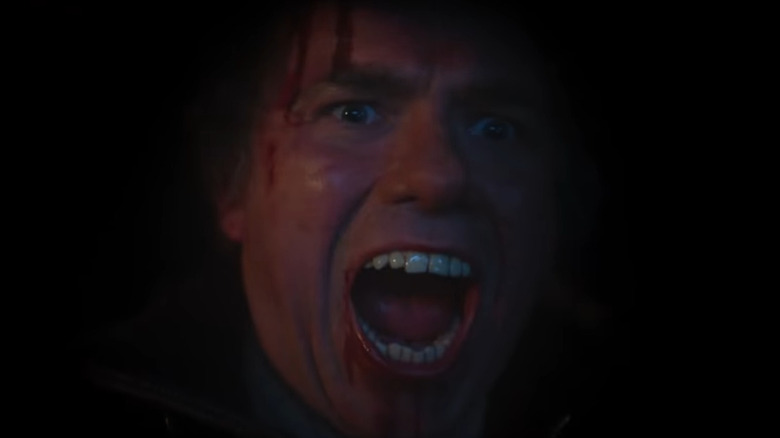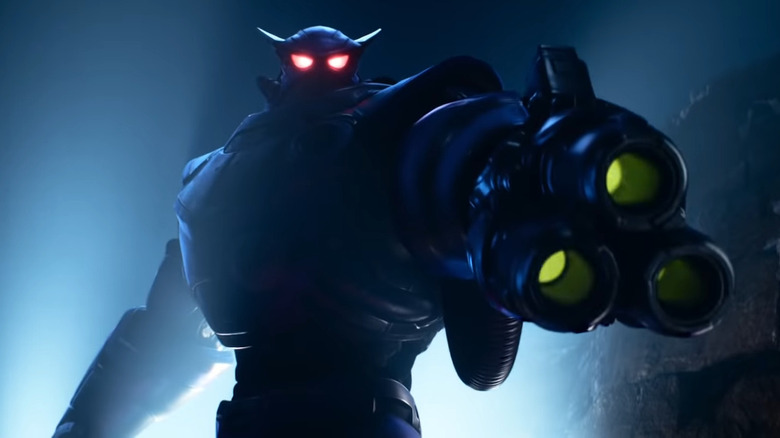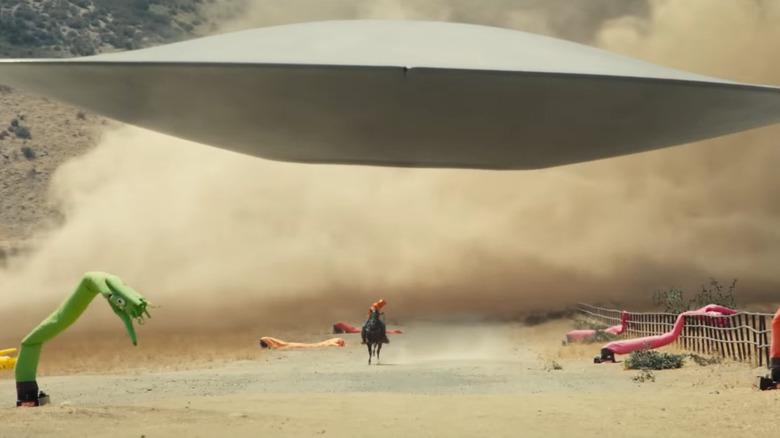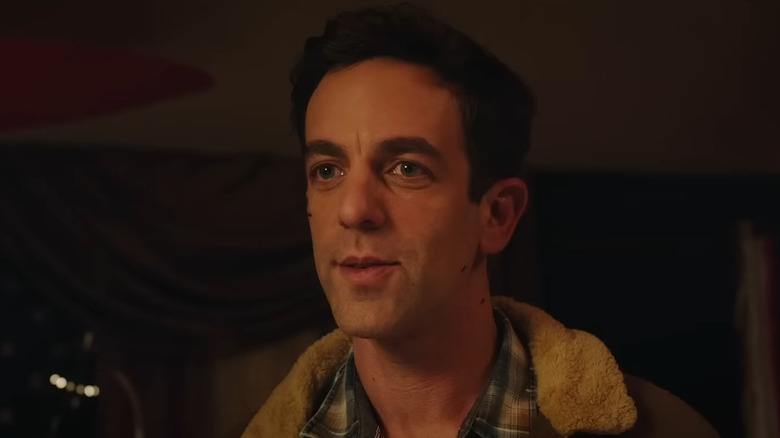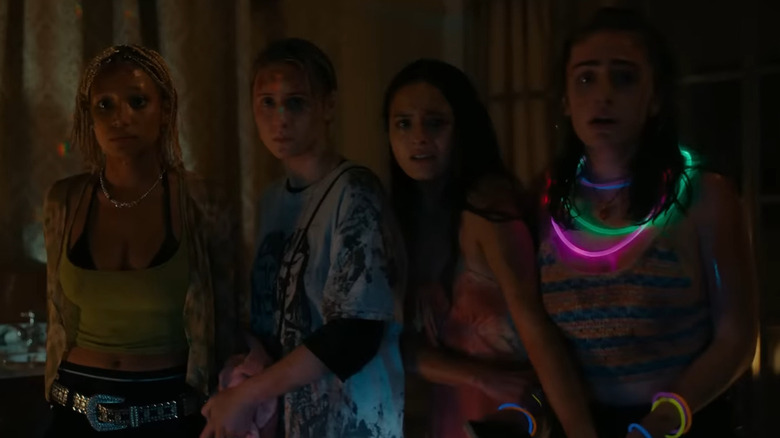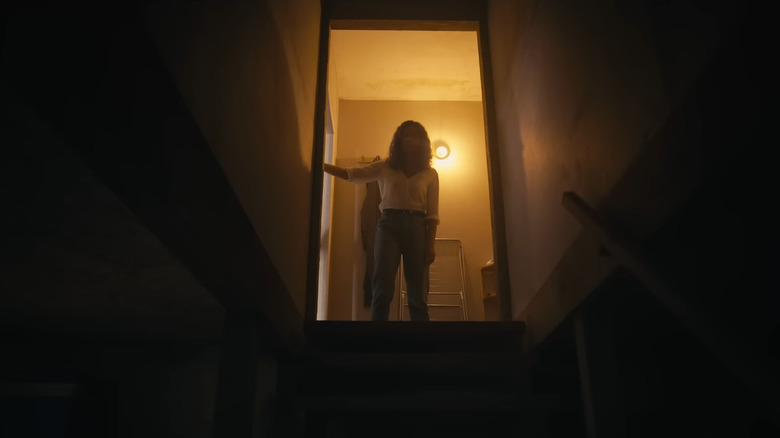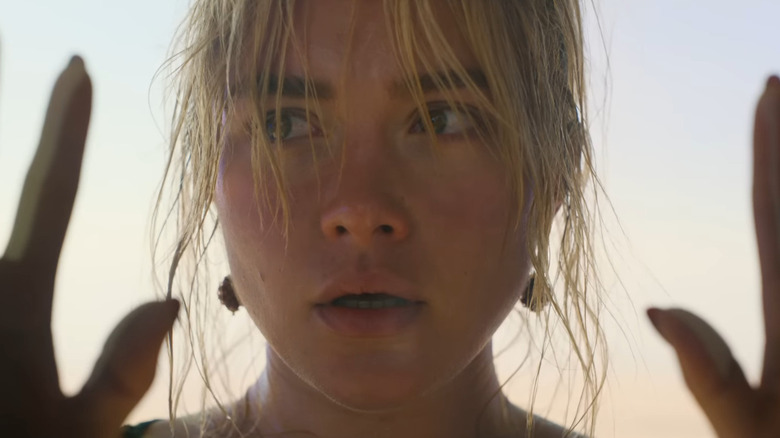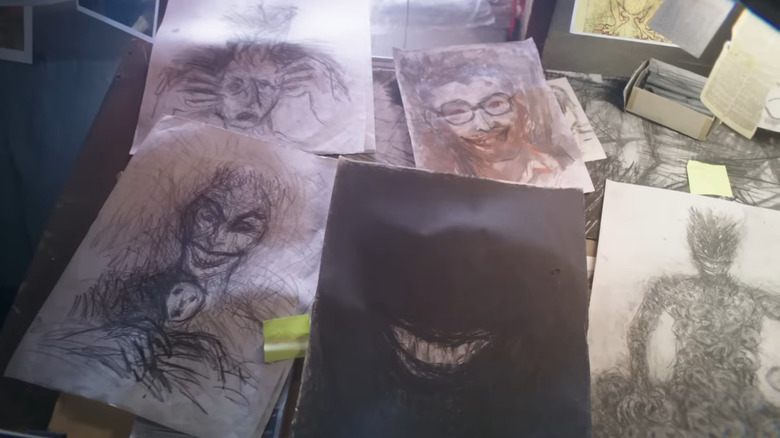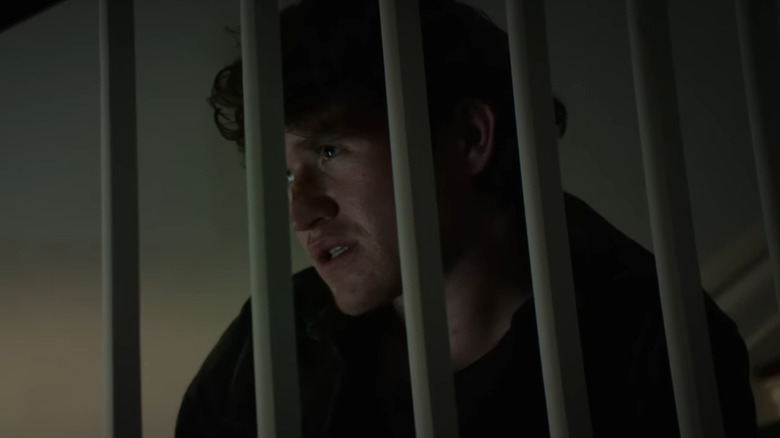The Biggest Movie Plot Twists Of 2022
Few things cause a film to stick in the viewer's mind after they've seen it than a well-executed plot twist. Sometimes it's a new detail at the end of a story that makes one completely reevaluate everything they've witnessed up until this point, like the reveal of who the murderer was or the fact that the protagonist may not have been as reliable a narrator as had previously been assumed. Sometimes the twist happens around the halfway mark and completely changes the dynamic of the film moving forward, such as the surprise death of a major character or an abrupt shift in genre. In some cases, a major twist might even come relatively early on in a film's story, and the surprise has less to do with how this revelation affects the story and is more about some key detail that's been strategically removed from the film's marketing in order to keep overall plot details as obscured as possible.
Considering that M. Night Shyamalan, who is perhaps the patron saint of the movie plot twist, did not have a new film to release in 2022 (though we don't have to wait long, as "Knock at the Cabin" releases early next year), it's still been quite the impressive year for plot twists in cinema. From massive blockbusters to intimate little indie films and everything in between, there've been many shocks and surprises at the movies. Listed below are some of the biggest movie plot twists we've seen this year.
Fair warning: Spoilers ahead.
The whole night was planned in The Outfit
"The Outfit" is the kind of film that delivers significant twists every 20 minutes or so. Coming to us from Oscar-winning screenwriter Graham Moore, who makes his feature directorial debut with the film, the story follows a masterful tailor named Leonard (he prefers to be known as a cutter) who runs a respectable shop in 1956 Chicago. Though he knows that several of his clientele is heavily involved in the criminal underworld, he initially seems to pay it all no mind. That is until the son of a local mob boss is brought into his store with a bullet wound in his gut, forcing Leonard to get increasingly involved over the course of a long, violent night.
As we watch Leonard maneuver his way through various interactions with the gangster element, it becomes clear that he's both far sharper and far more observant than his potential enemies have given him credit for. This is no coincidence, as towards the end of the movie we learn that Leonard has actually set in motion all the events of the film. It turns out that the soft-spoken, seemingly mild-mannered tailor was once a mob enforcer himself, and when he tried to leave his criminal life behind, his old gang tracked him down and murdered his family. It's the kind of twist that makes the movie highly rewatchable, so viewers can go back through looking for clues that he's the mastermind all along.
The Northman's mother lacks loyalty
If there's one thing that writer/director Robert Eggers loves as much as period authenticity, it's the exploration of prickly family dynamics. This was front and center in his directorial debut, 2016's "The Witch," which depicts a New England family in the 1600s that becomes gradually distrustful and malicious towards one another as they seem to fall under the spell of black magic. Though no family to speak of exists in his 2019 follow-up "The Lighthouse" (aside from the fact that the relationship between that film's leads is similarly thorny), the filmmaker returned to dissect a very different kind of relative aggression with his Viking revenge saga, "The Northman." The new film stars Alexander Skarsgård as Amleth, a former prince whose beloved father is slain by his uncle.
Throughout the film, Amleth recites a mantra that has kept him alive and focused over the years: "I will avenge you, Father. I will save you, Mother. I will kill you, Fjölnir." He poses as a slave in his uncle's domain to gain access and is finally able to reunite with his long-lost mother (Nicole Kidman). Rather than the warm welcome he expected, his mother has little more than contempt for her offspring and reveals that she had begged Fjölnir to kill his brother, who had frequently abused her. This all completely shatters Amleth's worldview, as the principles on which his life and vengeance had been founded are shown to be lies. He still kills his uncle, though.
Doctor Strange in the Multiverse of Madness lets Wanda break bad
Any film that shows a super-powered sorcerer traveling through multiple dimensions and encountering alternate versions of himself and other beloved characters is undoubtedly going to have more than a few twists and turns along the way. Doubly so if it's helmed by "Evil Dead" and "Spider-Man" director Sam Raimi, who never saw a cackling corpse or a supernatural book he didn't like. This all makes it rather intriguing that the biggest plot twist of "Doctor Strange in the Multiverse of Madness" occurs within the first 30 minutes or so. When aforementioned magic-wielder Stephen Strange (Benedict Cumberbatch) seeks out old ally Wanda Maximoff (Elizabeth Olsen) for assistance with protecting a universe-hopping teenager, he discovers that the malevolent force he hopes to combat is none other than Wanda herself.
At this point, Olsen had played the character in four films and a recent Disney+ series (a psychological sitcom riff known as "WandaVision"), all of which painted the character as a deeply troubled but ultimately good-hearted heroine who has always gone out of her way to fix her mistakes. Now that she's under the influence of the sinister Darkhold, however, Wanda finally makes the transition to full-blown supervillain. Though the film's trailer and early marketing acknowledged her presence, there was no indication that she was the big bad of the piece until it actually released in theaters. For now, it remains to be seen whether Wanda will return and potentially redeem herself.
The true form of the Men
Writer-director Alex Garland knows a thing or two about some twisty concepts. After gaining recognition for his scripts to several Danny Boyle classics (including "28 Days Later..." and "Sunshine"), he began directing his own work with 2014's "Ex Machina," which explored the morality behind creating AI and human nature on an intimate scale. His next film, 2018's "Annihilation," delved into more cerebral concepts about nature and the ways in which we sow the seeds of our own destruction. In other words, heady stuff. His most recent effort is this year's "Men," which stars Jessie Buckley as a woman taking a holiday in the country while processing the death of her abusive husband.
Any rest or relaxation she might have are short-lived when she finds herself annoyed, then accosted, and eventually attacked by the various men in the small town, all of whom are played by a chameleonic Rory Kinnear. What at first appears to be a clever casting gimmick (highlighting how the different forms of aggression all come from the same source) turns out to be far more literal, as the third act of the film reveals that not only do they all look the same, but they are literally the same entity. This builds to a climactic body horror showcase where each version of Kinnear proceeds to give birth to the next, until finally, the last one takes the form of her late husband, driving the themes of generational abuse home.
The identity of Zurg in Lightyear
On paper, a spin-off of the widely beloved "Toy Story" franchise focusing on fan-favorite character Buzz Lightyear should be a slam dunk success. And while the film was generally well-received, the less-than-stellar box office seemed to suggest that audiences may have been confused by the overall premise. Rather than taking the same Tim Allen-voiced version of the character that we all know, "Lightyear" is intended to be the film within the "Toy Story" universe that made Andy want a Buzz Lightyear toy in the first place. This conceit doesn't hold up to much scrutiny: The positive depiction of a multiracial same-sex marriage would have been very progressive for the mid-'90s, and it's hard to imagine Buzz was the only one of the many colorful characters who would get his own toy.
Still, it makes for an entertaining space adventure as Buzz (here voiced by Chris Evans) tries to find a way to save the colony he accidentally stranded on a desolate planet while fighting against the mysterious Zurg (James Brolin). Anyone who saw "Toy Story 2" knows that film recycled a classic twist from "The Empire Strikes Back" by revealing Zurg to be Buzz's father, but the filmmakers here have taken a different route. This Zurg turns out to be an older version of Buzz from the future, who will go to insane lengths to reverse the mistake he made as a young man. It ties in with Buzz's narrative arc perfectly.
The mystery of Nope's UFO
If we know anything about the films of Jordan Peele, it's that he's always got some extra tricks up his sleeve. The marketing for his first film, the Oscar-winning "Get Out," did very little to hint at the nefarious machinations of its central family, while the trailers for "Us" refrained from offering any explanation for its creepy doppelgängers beyond unsettling imagery. So when the trailer for "Nope" was released, speculation was expectedly at an all-time high as fans tried to figure out what was really going on under the surface of what appeared to be some kind of alien invasion movie.
"Nope" does indeed deal with aliens of a sort (or at least one), although calling it an invasion would be charitable. As we follow the Haywood siblings (played by Daniel Kaluuya and Keke Palmer), we see them attempt to capture legitimate footage of what appears to be a flying saucer that's been seen around their ranch. Around the film's halfway point, however, they make a startling discovery: The circular shape that's been stalking them isn't a vehicle for aliens, but rather an alien being itself, which has been sucking up people and animals for food and has become territorial as a result. This connects to the film's larger ideas about the commodification of spectacle, as our heroes now understand that they're not working to outsmart a race of intelligent beings, but rather to outmaneuver a powerful beast with a ravenous appetite.
The killer's motivation in Vengeance
The feature directorial debut of B.J. Novak (of "The Office" fame) was sadly a film that wasn't as financially successful as it could have been, but those who gave it a shot were rewarded with a comedic murder mystery that has a lot to say about the current political divide in America, as well as having a lot to say about people who have a lot to say about things. "Vengeance" tells the story of an affluent New York-based podcaster named Ben Manalowitz (played by Novak) who finds himself in the middle of rural Texas after being invited to the funeral of a girl he once hooked up with. The catch, however, is that she led her family to believe that she and Ben were soulmates, which leads to plenty of uncomfortable intimacy.
It also leads to a surprisingly involved whodunit as the girl's brother (Boyd Holbrook) is convinced that her supposed overdose was actually a case of murder. As it turns out, the answer is a bit of both. While she did OD, her drug habit was enabled and encouraged by a local music producer (Ashton Kutcher) who had hoped to lure in a media type like Ben in order to make them both famous as characters in a real true crime story. The film's critiques of a society that wants to find celebrity at any cost are crystalized in this character, with Ben ultimately deciding to kill him rather than join in.
If you or anyone you know needs help with addiction issues, help is available. Visit the Substance Abuse and Mental Health Services Administration website or contact SAMHSA's National Helpline at 1-800-662-HELP (4357).
Who is the killer in Bodies Bodies Bodies
Dutch actress and filmmaker Halina Reijn made her English-language directing debut with the timely-to-a-fault black comedy "Bodies Bodies Bodies" that skewers the privileges of youth and the desire for victimhood among those who have it all. The film sees a new couple (played by Amandla Stenberg and Maria Bakalova) who join the former's group of friends for a house party during a hurricane. As they proceed to drink, smoke, and ingest all of the many, many drugs that are scattered around the house, it is proposed that they play the titular game of "Bodies Bodies Bodies," a hide-and-seek-esque affair where they have to determine who the supposed killer is among them.
Things take a turn when they discover one of the two men present (Pete Davidson) is dead with a machete lodged in his neck. The easily rattled group immediately starts pointing fingers and distrusting each other, and as various interpersonal dramas are dredged up, they also start to die one by one. The natural assumption would be that one of them is using the cover of the hurricane to kill off the others, right? Wrong. The film ends with the highly strung-out Stenberg and Bakalova being the only ones left alive, and when they check out Davidson's phone, they find a video showing that he had accidentally committed suicide while attempting a stunt with the machete. Which means that, in their stoned paranoia, the rest of them accidentally killed themselves or each other. Whoops.
What's in the basement of Barbarian
If you only watched the trailer for "The Whitest Kids U'Know" alumni Zach Cregger's directorial debut, you'd be forgiven for not really knowing what to expect. That's because most of what's in the "Barbarian" trailer only comes from the first 15 minutes of the movie, give or take. We see two attractive young people (Georgina Campbell and "It" star Bill Skarsgård) who end up at the same rental home due to a booking error, and for a while, it's not clear whether he plans to kill her or whether they're going to fall in love. Much of the film's early tension comes from the feeling that either outcome is equally possible. That is, at least, until Campbell's character starts to check out the basement.
The beauty of Skarsgård's casting is that he's a complete red herring: The actual threat that arrives to announce this as a full-throated horror movie is a giant, deformed, naked woman who immediately caves the former's skull open. The only thing more shocking than the sudden reveal of such a ghoulish creature is the abrupt jump to a seemingly unrelated storyline about Justin Long being an actor accused of misconduct. The storylines do eventually tie together, and we learn that the Mother (as she's listed in the credits) is the result of generations of inbreeding, among other horrific acts, in a film that highlights just how awfully men will treat women when they can get away with it.
The secret behind Don't Worry Darling's idyllic town
It's a pity that most of the discourse surrounding actress Olivia Wilde's second directorial outing (following the critically-acclaimed high school comedy "Booksmart") had less to do with the movie and more to do with the perceived drama between the actors in the film. This is not to say that "Don't Worry Darling" is some misunderstood masterpiece, just that a film should be able to stand on its own merits rather than the supposed squabbles between its creative talent. Set in an idyllic 1950s-era community known as Victory, the film centers on a young housewife named Alice (Florence Pugh) as she begins to suspect that there's something very wrong with the town she lives in.
Compounding her suspicions after witnessing a variety of strange phenomena is that her husband Jack (Harry Styles) and his boss Frank (Chris Pine) regularly gaslight her by dismissing her concerns and emphasizing the perfect world that they get to inhabit. As we learn towards the end, the town's perfection is very much by design: it turns out that Victory is actually a computer simulation in which the housewives are obliviously trapped while the husbands work to afford the service and take care of their bodies in the real world. Though the twist doesn't quite explain all of the bizarre events Alice bore witness to, it does radically change the dynamic between her and her husband, and she ends up killing him in order to escape Victory.
The extent of Smile's curse
One of the surprise horror hits of the year (at least in terms of box office), "Smile," the directorial debut from Parker Finn, conjures up similar curse-based horror stories like "The Ring," "It Follows," and the work of Junji Ito to create an experience that's both eerily familiar and yet hauntingly distinct. Our protagonist is Dr. Rose Cotter (Sosie Bacon), a psychiatrist who witnesses a patient brutally killing herself after warning of an entity that makes its presence known through the titular "Smile." It doesn't take long before Rose realizes that she's the latest victim of the curse, as she starts to see the smile on the faces of strangers and loved ones alike.
With the assistance of her police detective ex-boyfriend (Kyle Gallner), she discovers that the curse feeds on trauma and is passed along by its victims committing suicide in front of a witness, thereby passing it on to the next person. Rose does everything she can to break the chain and even considers killing a patient in front of her boss as a way to bypass her own potential death. But in the end, we see there is no escape, as the entity reveals itself to her in the guise of her dead mother, with its proportions stretching to impossible lengths. Before consuming her and completing her section of the curse, it takes on its final form, that of a monstrous, skinless creature with multiple rows of nested mouths. Instant nightmare fuel.
If you or someone you know needs help with mental health, please contact the Crisis Text Line by texting HOME to 741741, call the National Alliance on Mental Illness helpline at 1-800-950-NAMI (6264), or visit the National Institute of Mental Health website.
If you or anyone you know is having suicidal thoughts, please call the National Suicide Prevention Lifeline by dialing 988 or by calling 1-800-273-TALK (8255).
Halloween Ends mostly focusing on Corey
Few franchises have experienced such high highs or such low lows as "Halloween." After John Carpenter's minimalist slasher film became a wildly influential sensation, there have been decades of sequels, reboots, and remakes all attempting to either replicate the original's success or to find a way to build off of it. Your mileage may vary on how successful any of them are, but in 2018 director David Gordon Green introduced a soft reboot (also titled "Halloween") that created a new story while tapping into the enduring legacy of the franchise's two key players: that being the killer Michael Myers, and his perennial victim Laurie Strode (Jamie Lee Curtis).
The film was a massive financial success, and quickly spurred the creation of two additional sequels. While "Halloween Kills" mostly trods the same familiar ground as its forebears, this year's "Halloween Ends" goes in a radically different direction, choosing to focus almost exclusively on a new character named Corey Cunningham (Rohan Campbell). Despite the film's marketing heavily playing up the final showdown between Michael and Laurie, Green revealed that their big fight at the end was a late addition and that the intention was always to focus on Corey (who is barely seen in the film's trailer). As such, fans were understandably shocked to see that the film mostly devotes itself to his persecution by the residents of Haddonfield for an accidental crime, leading him to let out his rage as a new Michael-esque killer.
